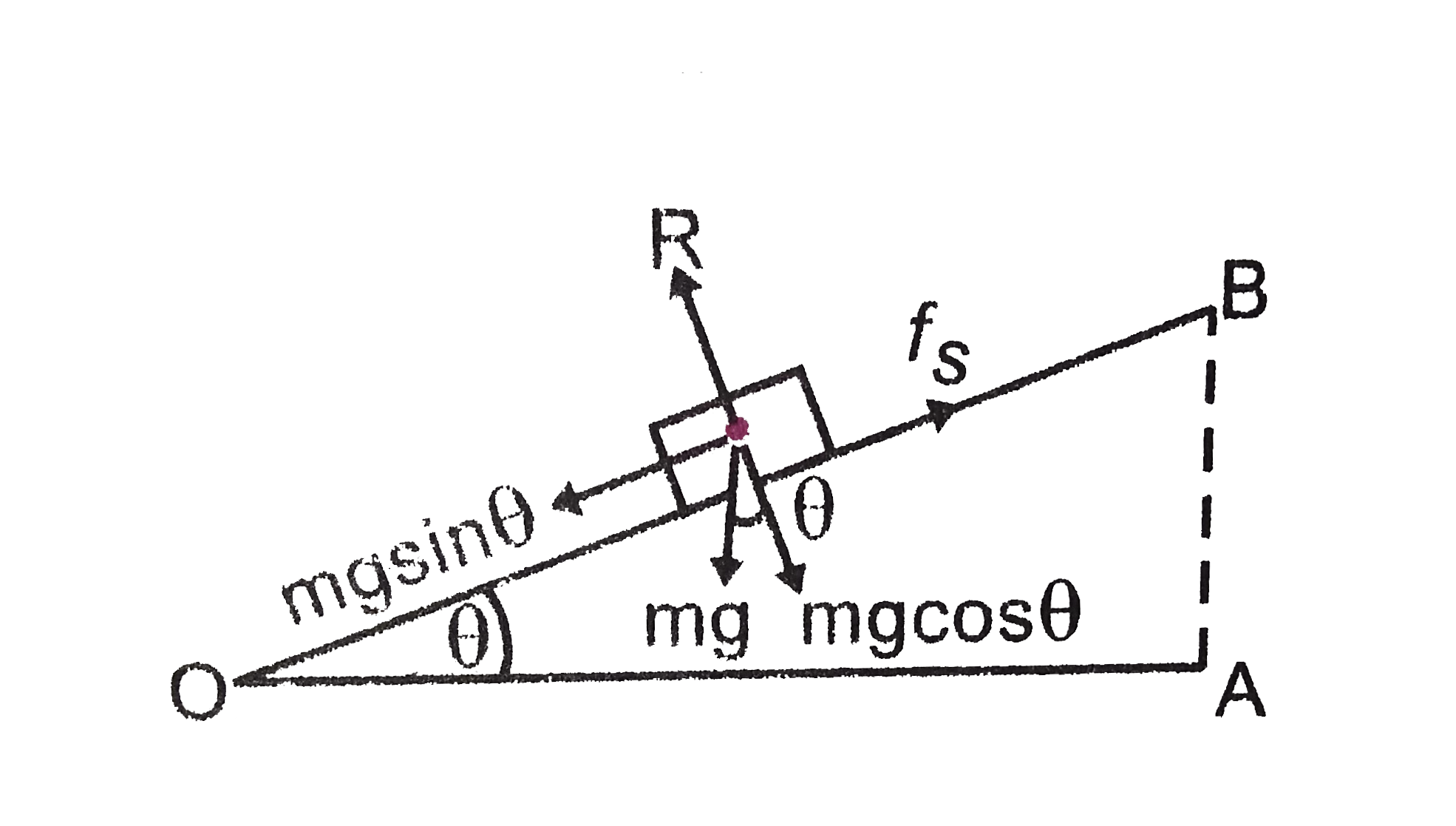A rocket is fired vertically from the earth with an acceleration of 2g, where g is the gravitational acceleration. On an inclined plane inside the tocket, making an angle θ with the horizontal, a point object of mass m is kept, the minimum coefficient of friction μmin between the mass and the inclined suface such that the mass does not move is:
2tanθ
3tanθ
tanθ
tan2θ
The correct Answer is:C
To solve the problem, we need to determine the minimum coefficient of friction (μ_min) required to prevent a mass m from sliding down an inclined plane inside a rocket that is accelerating upward with an acceleration of 2g.
1. Identify the Effective Acceleration:
The rocket is accelerating upward with an acceleration of 2g. Therefore, the effective gravitational acceleration acting on the mass inside the rocket is:
geffective=g+2g=3g
2. Analyze Forces on the Mass:
The mass m experiences two forces:
- The gravitational force acting downward, which is Fg=mgeffective=3mg.
- The normal force (N) exerted by the inclined plane, which acts perpendicular to the surface.
3. Resolve Forces Along the Incline:
The gravitational force can be resolved into two components:
- Along the incline: F∥=3mgsinθ
- Perpendicular to the incline: F_{\perpendicular} = 3mg \cos \theta
4. Determine the Normal Force:
The normal force (N) acting on the mass is equal to the perpendicular component of the gravitational force:
N=3mgcosθ
5. Frictional Force:
The frictional force (F_f) that opposes the motion of the mass down the incline is given by:
Ff=μN=μ(3mgcosθ)
6. Set Up the Equation for Equilibrium:
For the mass to remain at rest (not sliding down), the frictional force must balance the component of gravitational force acting down the incline:
Ff=F∥
Therefore, we have:
μ(3mgcosθ)=3mgsinθ
7. Simplify the Equation:
We can cancel 3mg from both sides (assuming m≠0):
μcosθ=sinθ
8. Solve for the Minimum Coefficient of Friction:
Rearranging the equation gives:
μ=sinθcosθ=tanθ
Thus, the minimum coefficient of friction required to prevent the mass from sliding down the incline is:
μmin=tanθ
The rocket is accelerating upward with an acceleration of 2g. Therefore, the effective gravitational acceleration acting on the mass inside the rocket is:
geffective=g+2g=3g
The mass m experiences two forces:
- The gravitational force acting downward, which is Fg=mgeffective=3mg.
- The normal force (N) exerted by the inclined plane, which acts perpendicular to the surface.
The gravitational force can be resolved into two components:
- Along the incline: F∥=3mgsinθ
- Perpendicular to the incline: F_{\perpendicular} = 3mg \cos \theta
The normal force (N) acting on the mass is equal to the perpendicular component of the gravitational force:
N=3mgcosθ
The frictional force (F_f) that opposes the motion of the mass down the incline is given by:
Ff=μN=μ(3mgcosθ)
For the mass to remain at rest (not sliding down), the frictional force must balance the component of gravitational force acting down the incline:
Ff=F∥
Therefore, we have:
μ(3mgcosθ)=3mgsinθ
We can cancel 3mg from both sides (assuming m≠0):
μcosθ=sinθ
Rearranging the equation gives:
μ=sinθcosθ=tanθ
μmin=tanθ
Topper's Solved these Questions
- BOOK - ALLENCHAPTER - NEWTON'S LAWS OF MOTION & FRICTIONEXERCISE - EXERCISE (JA)4videos
NEWTON'S LAWS OF MOTION & FRICTION
- BOOK - ALLENCHAPTER - NEWTON'S LAWS OF MOTION & FRICTIONEXERCISE - EXERCISE (O-2)31videos
NEWTON'S LAWS OF MOTION & FRICTION
- BOOK - ALLENCHAPTER - MOTION IN A PALNEEXERCISE - SOLVED EXAMPLE28videos
MOTION IN A PALNE
- BOOK - ALLENCHAPTER - NEWTONS LAWS OF MOTIONEXERCISE - EXERCISE-III28videos
NEWTONS LAWS OF MOTION
Similar Questions
When a solid sphere rolls without slipping down an inclined plane making an angle θ with the horizontal, the acceleration of its centre of mass is a. If the same sphere slides without friction, its.
View SolutionA block slides down an inclined plane that makes an angle θ with the horizontal. If the coefficient of kinetic friction is μ, find the acceleration of the block.
View Solution
Knowledge Check
- Question 1 - Select One
When a solid sphere rolls without slipping down an inclined plane making an angle θ with the horizontal, the acceleration of its centre of mass is a. If the same sphere slides without friction, its.
A72 aB57 aC75 aD52 a
A mass of 2kg rests on a horizontal plane. The plane is gradually inclined until at an angle θ=20∘ with the horizontal, the mass just begins to slides. What is the coefficient of static friction between the block and the surface ?
View SolutionA block of mass m slides down an inclined plane which makes an angle θ with the horizontal. The coefficient of friction between the block and the plane is μ. The force exerted by the block on the plane is
View SolutionA block of mass 4kg rests on a rough horizontal plane. The plane is gradually inclined until at an angle θ=60∘ , with the vertical, the mass just begins to side. What is the coefficient of static friction between the block and the plane?
View SolutionA mass of 4 kg rest on a horizontal plane . The plane is gradually inclined until an angle 0=15∘ with the horizontal and the mass just begins to slide . What is the coefficient of static friction between the block and the surface ?
 View Solution
View SolutionA block of mass m is placed on a rough plane inclined at an angle θ with the horizontal. The coefficient of friction between the block and inclined plane is μ . Ifθ<tan−1(μ) , then net contact force exerted by the plane on the block is :
View SolutionA block of mass m is placed at rest on an inclination θ to the horizontal. If the coefficient of friction between the block and the plane is μ, then the total force the inclined plane exerts on the block is
View SolutionA small mass slides down an inclined plane of inclination θ with the horizontal the coefficient of friction is μ=μ0x, where x is the distance through which the mass slides down. Then the distance covered by the mass before it stops is
View Solution

